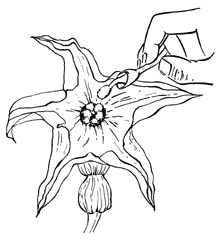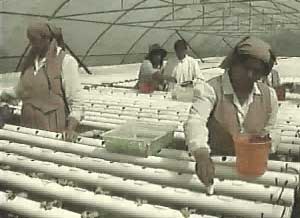Background Information
Artificial plant breeding has been done for thousands of years. Since the beginning of farming, farmers have selectively chosen the plants they wish to continue to grow. The farmers planted seeds harvested from the plants that were the biggest, healthiest, or tastiest. This reproduces plants similar to the desired phenotype, although the farmers hundreds of years ago did not know their chances of success or understand the process of passing traits through generations (Butler). Initial variation to a plant can be induced by changing conditions where the plant is grown. This will eventually force the plant to adapt to more extreme conditions (Bailey, 1906). For example, continuously growing seeds from a plant in colder conditions will slowly make that plant more likely to survive in a colder climate (Bailey, 1906). Though it began with haphazard planting of seeds, plant breeding has become a specific science to manipulate the characteristics of plants. Plant breeding is defined as the controlled pollination of plants (Butler).
Plant Reproduction
Plants are able to reproduce asexually or sexually. Asexual reproduction occurs when a portion of a plant is separated from the plant body, and it is able to develop into an entirely new plant (Butler). This remarkable ability to dedifferentiate and become a whole plant can occur using a cutting from leaf, root, or stem (Butler). This allows scientists and farmers to create transgenic plants by splicing pieces of two different plants and culturing them together to make a new genotype and phenotype of a plant. If these new plants can reproduce, then a new species of plant has been introduced. But if the plant is sterile, then it must be constructed repeatedly in the laboratory.
More commonly, plants may also breed sexually. This is the union of the male and female germ cells, and this type of reproduction causes some genetic variation (Butler). Sexual reproduction occurs in the flower of a plant. A plant's flower may be perfect, having both male and female reproductive organs, or imperfect (Butler). Imperfect flowers have only one type of sex organ (Butler). Plants may contain all flowers that are female or all flowers that are male, or they may have separate male and female flowers on the same plant. During sexual reproduction the male sex organ, the stamen, produces pollen from the anther. These male germ cells find their way to the female sex organ, the pistil, whose base is the ovary (Butler). This is where fertilization takes place. In order to breed plants, pollen must be removed from the chosen plant and placed on the pistil of the other chosen plant (Butler). It is important to remove unwanted pollen from the receiving female plant if necessary (Butler). (See Figure 1)
This is the basic procedure for breeding two plants. After fertilization occurs, an artificially reproduced plant will grow. The simplest way to breed plants is to cross pollinate, using the parent plants of your choice (Butler). This controls the gene pool, and it can be repeated for generation after generation of offspring. For more information on the details of manually breeding plants and instructions for how to do it yourself, visit Plant Breeding as a Hobby. This style of plant breeding will eventually create the desired traits in the plants. A basic knowledge of Mendelian genetics (see below) helps understand the typical outcome of plant breeding. Manual pollination has been the original process of manipulating genes, but it has now been upstaged by the advent of modern methods of gene transfusion.
 Figure
1: Demonstration of artificial addition of pollen to flower. Photo courtesy
of JD Butler. Permission pending for use.
Figure
1: Demonstration of artificial addition of pollen to flower. Photo courtesy
of JD Butler. Permission pending for use.
Mendelian Genetics
Plants inherit characteristics in a similar manner to animals. Each cell contains two genes that display a trait. Germ cells only contain one copy of the gene, so when the gametes combine, each contribute one gene (Butler). The principles of plant breeding boil down to Mendelian genetics. If two plants that are homozygous dominant for one gene are crossed, their offspring will all display that trait (Butler). If two plants are heterozygous, then their offspring will display different versions of the trait (Butler). This antiquated method of plant breeding results in many trials and errors, but will be successful for visible traits of a plant. The laws Mendel defined are the basis for plant breeding, although with current technology, the experiments are much more detailed. The basics of genetics still dictate the process of plant breeding and for more details on genetics click here. For more information on Mendel and his work, go to MendelWeb.
Costs and Benefits
Plant breeding could be considered the founding father of genetically modified organisms. It began with the advent of farming, and its techniques have advanced significantly since then. Plant breeding still proves to be the most basic form of modifying plants, and its principles lend themselves to other methods of modifying organisms. This method is the least technical procedure of altering plant genes, and can even be carried out by the general public. In addition, plant breeding opens up many possibilities for the farmer and consumer. With plant breeding, crops are modified to alter the lipid, starch, or protein content. Plants may be altered to increase pest and virus resistance, or plants can be grown to tolerate extreme habitats (Alberts et al, 2002). These modifications further the expansion of crop growing to support growing populations and increase nutritional value of the crops themselves. Unfortunately it is a slow process, because corn and tomatoes are plants which are easily studied and they have long life cycles and large genomes (Alberts et al 2002). This impedes the visual and genetic analysis of plant breeding. Many scientists study the arabidopsis thaliana plant, a common wall cress, because of its smaller genome and shorter life cycle.
Future of Plant Breeding
The practice of breeding plants by hand is still practiced today. (See Figure 2) The procedure has been surpassed in technology, but still remains useful for basic plant crossing. In recent news, scientists and researchers have developed increasingly advanced methods for inserting a foreign gene into plants. Numerous agricultural biotechnology companies invest large amounts of money in controlling the advancement of crop breeding. Unlike plant breeding, complicated biotechnology can transfer one or a few desirable genes. This allows for more control over the expression of specific traits. Furthermore, scientists can introduce traits that previously did not exist at all. For more information on biotechnology companies visit Monsanto's web site. This offers more details on biotechnology and how it works. Keep in mind this web site is run by a corporation that profits from crop breeding.
 Figure
2: Women breeding plants. Photo courtesy of United Nations Development Programme.
Figure
2: Women breeding plants. Photo courtesy of United Nations Development Programme.
References
Alberts, B., Johnson, A., Lewis, J., Raff, M., Roberts, K., and Walter, P. (2002) Molecular Biology of the Cell, 4th edn. (New York: Garland Science), pp. 543.
Bailey L.H. (1906) Plant Breeding, 4th edn. (New York: The Macmillan Company), pp. 42-45).
Butler JD Professor of Horticulture University of Illinois Extension Plant Breeding as a Hobby Accessed 9/01/02 <http://www.ag.uiuc.edu/~vista/html_pubs/PLBREED/pl_breed.html>
United Nations Development Programme Human Development Report 2001 Accessed 9/05/02 <http://www.undp.org/hdr2001>


